Insane in India, loving every bit of it
By Sharell Cook | 22 Aug 2009
 My flight to Chennai, where the Mumbai Xpress Rickshaw Challenge would be starting from, was delayed nearly an hour. This gave me plenty of time to think about what the next couple of weeks, participating in the Rickshaw Challenge, might bring.
My flight to Chennai, where the Mumbai Xpress Rickshaw Challenge would be starting from, was delayed nearly an hour. This gave me plenty of time to think about what the next couple of weeks, participating in the Rickshaw Challenge, might bring.
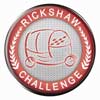 I felt totally unprepared. Even more troublesome, couldn’t help fearing what I’d suspected for quite a while — India had finally sent me insane. What other explanation could there be for me agreeing to take part in an event that’s billed as a rally for the “clinically insane”? An event that would require me and my team mate to drive an auto rickshaw for 13 days, over 1,900 kilometers and through four states, from Chennai to Mumbai.
I felt totally unprepared. Even more troublesome, couldn’t help fearing what I’d suspected for quite a while — India had finally sent me insane. What other explanation could there be for me agreeing to take part in an event that’s billed as a rally for the “clinically insane”? An event that would require me and my team mate to drive an auto rickshaw for 13 days, over 1,900 kilometers and through four states, from Chennai to Mumbai.
I first heard about the Rickshaw Challenge when I was contacted by the organiser, Chennai Event Management Services, to write a promotional piece about it. At the time, little did I know that not long after, a message would arrive in my inbox inviting me to actually participate in the event.
Despite living in India for over three years, I hadn’t been game enough to drive a car, let alone an auto rickshaw that I didn’t know how to operate. What’s more, as little as 30 minutes spent in one of those noisy three-wheeled contraptions was enough to irritate my ears and turn my hair into a knotted mess. How would I cope with 13 days in one? I had absolutely no idea. All I knew was that the opportunity was too hilarious and extraordinary to turn down.
 The air was hot and thick with humidity in Chennai, as all 27 Mumbai Xpress Rickshaw Challenge participants assembled at the grounds of St Mary’s College Campus to learn how to drive our auto rickshaws. We were a group of strangers from eight different countries, all united by our pursuit of adventure.
The air was hot and thick with humidity in Chennai, as all 27 Mumbai Xpress Rickshaw Challenge participants assembled at the grounds of St Mary’s College Campus to learn how to drive our auto rickshaws. We were a group of strangers from eight different countries, all united by our pursuit of adventure.
We quickly realised we were in for one crazy adventure. For four hours, the college grounds were treated like an obstacle course as we dodged swings, slides, other pieces of children's play equipment -- and of course, each other! Auto rickshaws revved, shuddered, spluttered, stalled, and yes, even broke down. I struggled to come to terms with the fact that the accelerator was located on the rickshaw’s handlebar. Every time I gripped the handlebar, the rickshaw dangerously surged forward.
Just when I felt like I’d gained some control over my rickshaw, I was struck with the very sobering realisation, which up until then had managed to remain buried in my mind — I would have to drive it in traffic tomorrow!
India’s roads are often narrow and filled with potholes, but it’s the traffic that’s the biggest hazard. It consists of all types, from trucks to bullock carts, and it approaches haphazardly and randomly from all directions. There are obstacles, such as the renowned cows on the road, which require dodging as well.
I soon came to acknowledge why Indian drivers honk their horns so much. It’s not merely a safety measure, more so it’s an outlet for the frustrations resulting from inconsiderate motorists and lack of traffic rules. Within just three days, I’d honked the horn more times than I had in my previous 17 years of driving. And I showed no signs of relenting!
The 13 teams in the Rickshaw Challenge eagerly set off from Chennai with great anticipation. The thrill of the unknown was heightened by the organiser’s resounding warning -- our rickshaws would have frequent mechanical problems. We could solve these ourselves, if we could find local mechanics, or call the support crew.
Not wanting to leave anything to chance, many teams armed themselves with satellite navigation devices to help find their way along India’s roads. I, on the other hand, preferred to do as the Indians do, and ask someone. This wasn’t particularly productive when I asked the hotel staff for the best route out of Chennai. "Your driver will know”, they advised me. “But I am the driver,” I exclaimed, to looks of amusement and dismay.
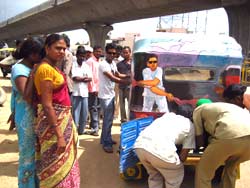 I didn’t have to wait long for the first mechanical issue to arise. It happened the second time the rickshaw was refuelled. Around 500 metres from the petrol pump, the rickshaw mysteriously spluttered, lost power, and stalled. Auto rickshaws run on a combination of petrol and oil, which I soon learned has to be properly mixed to prevent the motor becoming flooded with oil. My rickshaw liked its fuel to be extremely well mixed, and regularly reminded me of this by refusing to start after refuelling.
I didn’t have to wait long for the first mechanical issue to arise. It happened the second time the rickshaw was refuelled. Around 500 metres from the petrol pump, the rickshaw mysteriously spluttered, lost power, and stalled. Auto rickshaws run on a combination of petrol and oil, which I soon learned has to be properly mixed to prevent the motor becoming flooded with oil. My rickshaw liked its fuel to be extremely well mixed, and regularly reminded me of this by refusing to start after refuelling.
It readily became apparent that it was better to refuel and break down in cities than on highways. Willing helpers (plus the usual crowd of onlookers) appeared out of nowhere, and shops with spare parts were close by.
On the second day, the rickshaw ran out of petrol on the highway leading to Bangalore. A careless thing to let happen, you might be thinking. However, in a vehicle that doesn’t have a petrol gauge, it’s not so easily prevented. My team mate set off to try and get fuel. He returned to find me happily munching on a two-rupee masala guava.
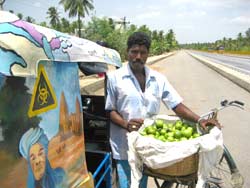 Usually, my biggest annoyance in India is that it’s so difficult to be alone anywhere. However, on this occasion, I was grateful for the constant stream of passersby. The guava vendor only spoke Tamil, but I got the impression that upon seeing the garlands hanging from the rickshaw and me, he thought I’d just gotten married.
Usually, my biggest annoyance in India is that it’s so difficult to be alone anywhere. However, on this occasion, I was grateful for the constant stream of passersby. The guava vendor only spoke Tamil, but I got the impression that upon seeing the garlands hanging from the rickshaw and me, he thought I’d just gotten married.
Life on the road developed into an exhausting routine of 6:00 am alarms, and all day spent driving. Nevertheless, the exhaustion was overridden by a rousing sense of wonderment over India’s ever changing kaleidoscope of scenery, and the unpredictable incidents that the day would bring. What curious sights would I see along the roads? Would the rickshaw break down again and where? Would we get pulled over by the police again? Would people give us incorrect directions, again making us lost? And when would we see the last of the rickshaw rattling potholes? Every day was a gripping new quest.
Encounters with policemen were frequent in Tamil Nadu and Karnataka. The most amusing of these took place when myself, and a number of other teams, simultaneously converged on a swanky new highway leading out of Bangalore to Mysore -- a highway lined with signs prominently announcing that auto rickshaws were prohibited. Two heavily laden police vans swiftly arrived on the scene, and insisted that we take an alternative route.
 Yet, most police encounters were due to curiosity about my purpose in driving a brightly painted rickshaw. These interactions required a convincing and authoritative stance on my part, so that I didn’t have to hand over monetary incentives to be able to continue my jaunt. Fortunately, upon finding out that a large component of the Rickshaw Challenge is charity related, the policemen were quite obliging.
Yet, most police encounters were due to curiosity about my purpose in driving a brightly painted rickshaw. These interactions required a convincing and authoritative stance on my part, so that I didn’t have to hand over monetary incentives to be able to continue my jaunt. Fortunately, upon finding out that a large component of the Rickshaw Challenge is charity related, the policemen were quite obliging.
The Rickshaw Challenge supports a charity by the name of Round Table India. I found it heartening to be given the opportunity to visit a number of their projects along the way, including schools for underprivileged children and a workshop for handicapped women.
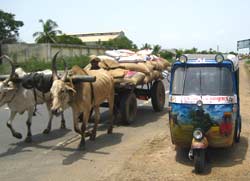 However, my biggest source of fascination during the trip was the diverse spectacle of traffic that paraded along the roads. Bullock carts were a common sight, as were people carrying bundles of goods on their heads, and farmers herding animals.
However, my biggest source of fascination during the trip was the diverse spectacle of traffic that paraded along the roads. Bullock carts were a common sight, as were people carrying bundles of goods on their heads, and farmers herding animals.
As I approached Mysore, I noticed a huge mound of coconut shells on the side of the road. Looking back after passing it, I was surprised to see an auto rickshaw precariously buried beneath it. I headed over for a closer inspection, and a man leaped up from underneath the pile. “Photo, photo”, he eagerly requested, while informing me that he and his two companions had come 120 kilometers to deliver the goods in Mysore. It had taken them one day to reach there, and would take them one day to return.
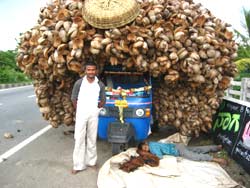 On the outskirts of Mangalore, I encountered another captivating scene -- two sadhus, and an elephant with a trunk painted as bright as their saffron robes. The elephant’s name was Lucky. The trio were heading north on foot, on a pilgrimage to the 2010 Kumbh Mela in Haridwar, one of the sadhus revealed to me. I held out some money. The elephant grabbed it with his trunk, and then raised it auspiciously.
On the outskirts of Mangalore, I encountered another captivating scene -- two sadhus, and an elephant with a trunk painted as bright as their saffron robes. The elephant’s name was Lucky. The trio were heading north on foot, on a pilgrimage to the 2010 Kumbh Mela in Haridwar, one of the sadhus revealed to me. I held out some money. The elephant grabbed it with his trunk, and then raised it auspiciously.
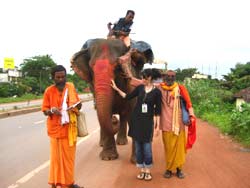 The reactions of auto rickshaw drivers entertained me as well. I’m not likely to forget the rickshaw driver who pulled up alongside me and challenged me to a race, or the auto rickshaw drivers in Mumbai who smiled at the sight of my rickshaw. “Accha lagta hai?” (Looking good?), I asked one as we queued up at the traffic lights. He smiled even more, and wobbled his head enthusiastically in response.
The reactions of auto rickshaw drivers entertained me as well. I’m not likely to forget the rickshaw driver who pulled up alongside me and challenged me to a race, or the auto rickshaw drivers in Mumbai who smiled at the sight of my rickshaw. “Accha lagta hai?” (Looking good?), I asked one as we queued up at the traffic lights. He smiled even more, and wobbled his head enthusiastically in response.
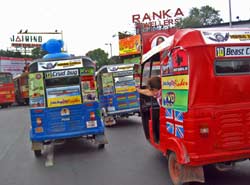 As the end of the Mumbai Xpress Rickshaw Challenge became closer, so too did the teams. We were bonded together by our shared challenges, accomplishments, and memories. Each night at our new destination, we looked forward to hearing everyone’s stories about what incidents had happened along the way.
As the end of the Mumbai Xpress Rickshaw Challenge became closer, so too did the teams. We were bonded together by our shared challenges, accomplishments, and memories. Each night at our new destination, we looked forward to hearing everyone’s stories about what incidents had happened along the way.
Looking back over the two weeks of the Mumbai Xpress Rickshaw Challenge, I’m so glad that I took the opportunity to prove that I am “clinically insane”. It was an exuberant and unforgettable experience, which sadly seems all too much like an outlandish dream now. Still, I feel empowered that I achieved something so astonishing. And best of all, my confidence in my capability to live in India has grown so much as a result.






















